Hi ! We hope this site helps you! ٩(ˊᗜˋ*)و As an Amazon Associate, we earn from qualifying purchases without additional cost. Click to read more about our Privacy Policy or Affiliate Disclosure
Japanese adjective behaves differently than English adjective which we are familiar with. But these are all you need to know about it.
BASIC CONJUGATION RULES FOR JAPANESE ADJECTIVE:
Conjugation is very important in Japanese. You need to conjugate to show the
Note that there are 2 types of adjectives
How to Conjugate い Adjective
Check out how to conjugate
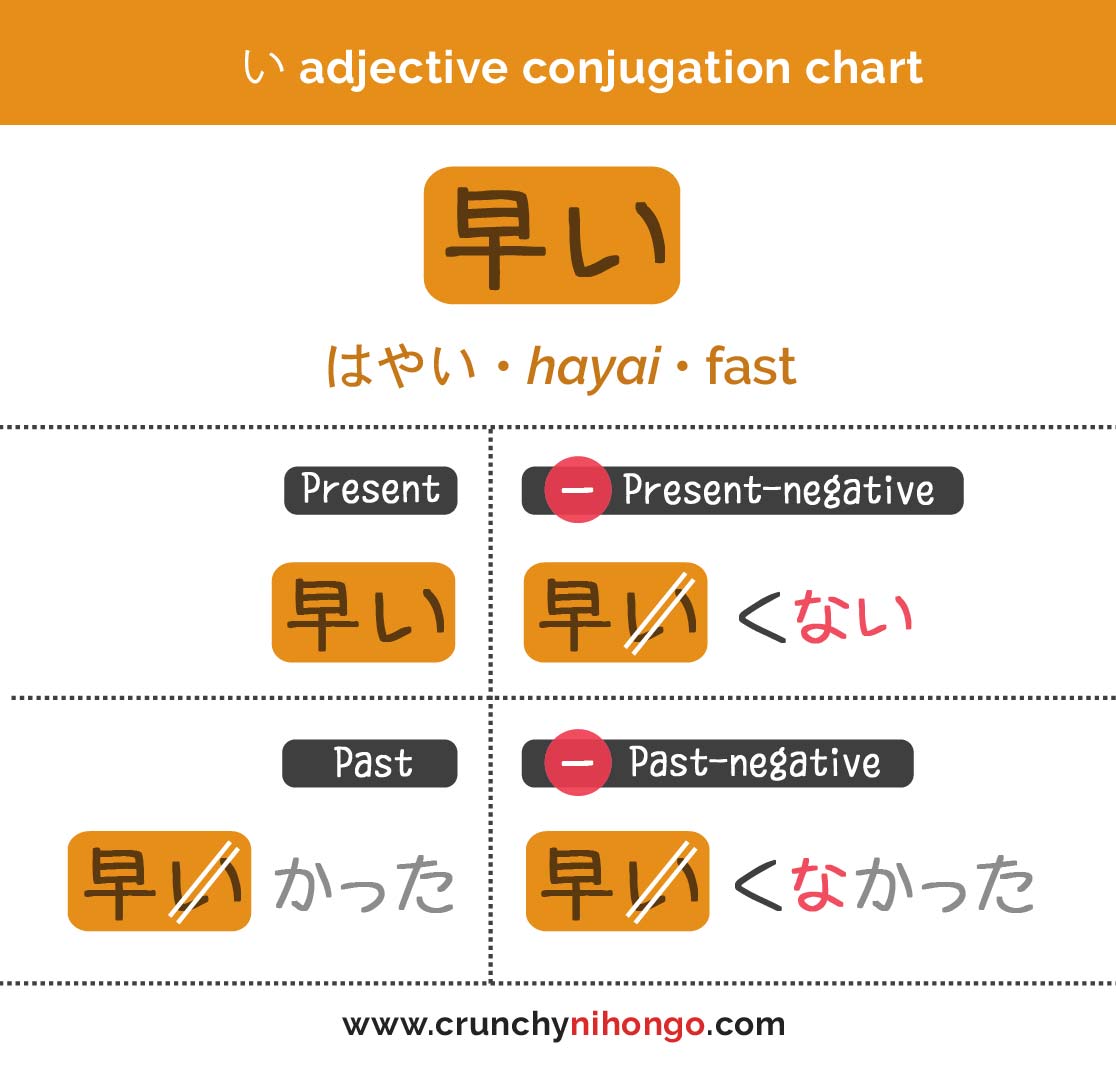
Sample Sentences
そのモルモットは
Sono Morumotto wa
That Guinea Pig
そのモルモットは
Sono Morumotto wa
That Guinea Pig
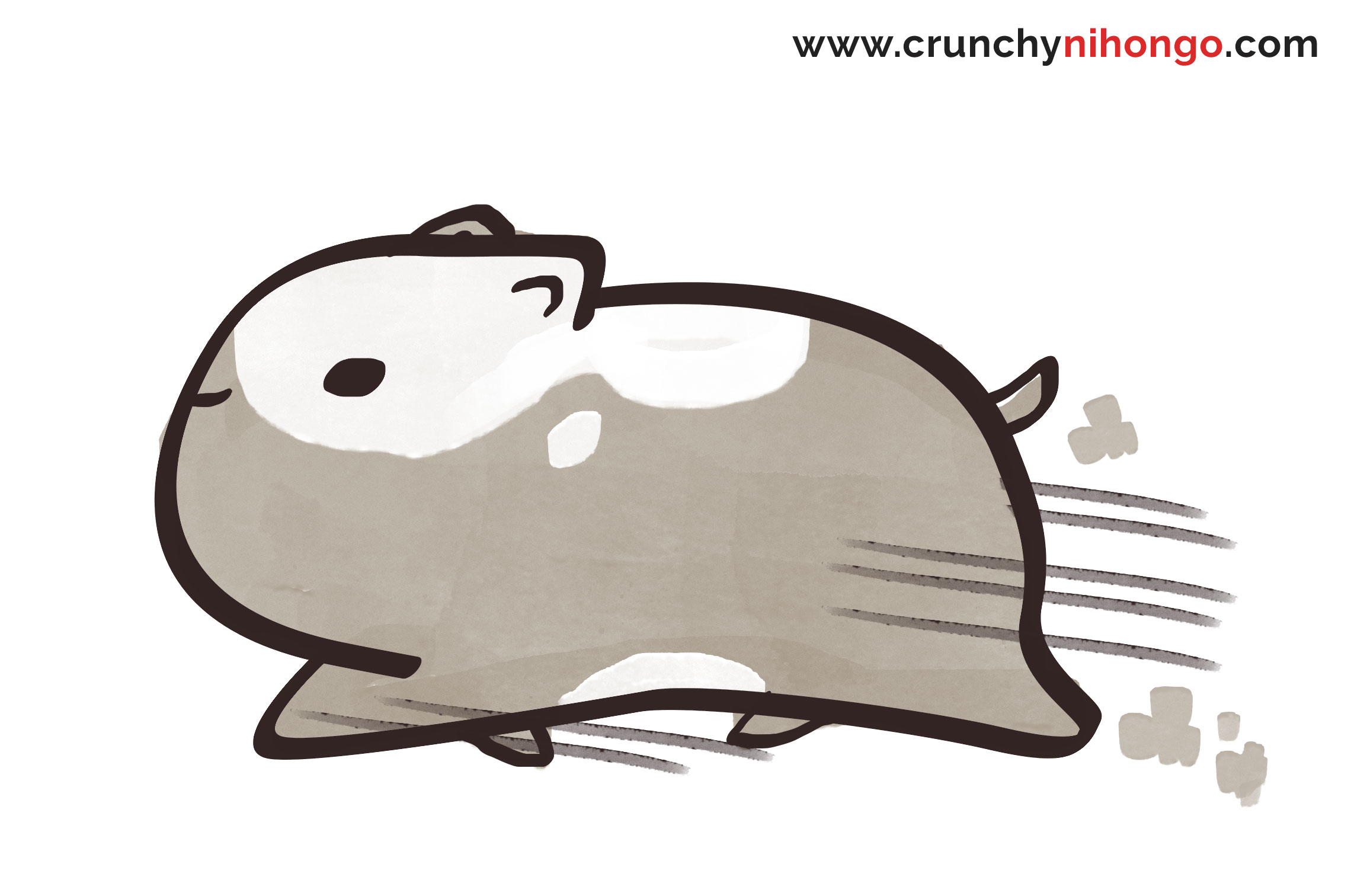
そのモルモットは
Sono Morumotto wa
That Guinea Pig
そのモルモットは
Sono Morumotto wa
That Guinea Pig

*All sample sentences are written as formal/polite version.
To make it informal, you can drop the
How To Conjugate な Adjective
Check out how to conjugate
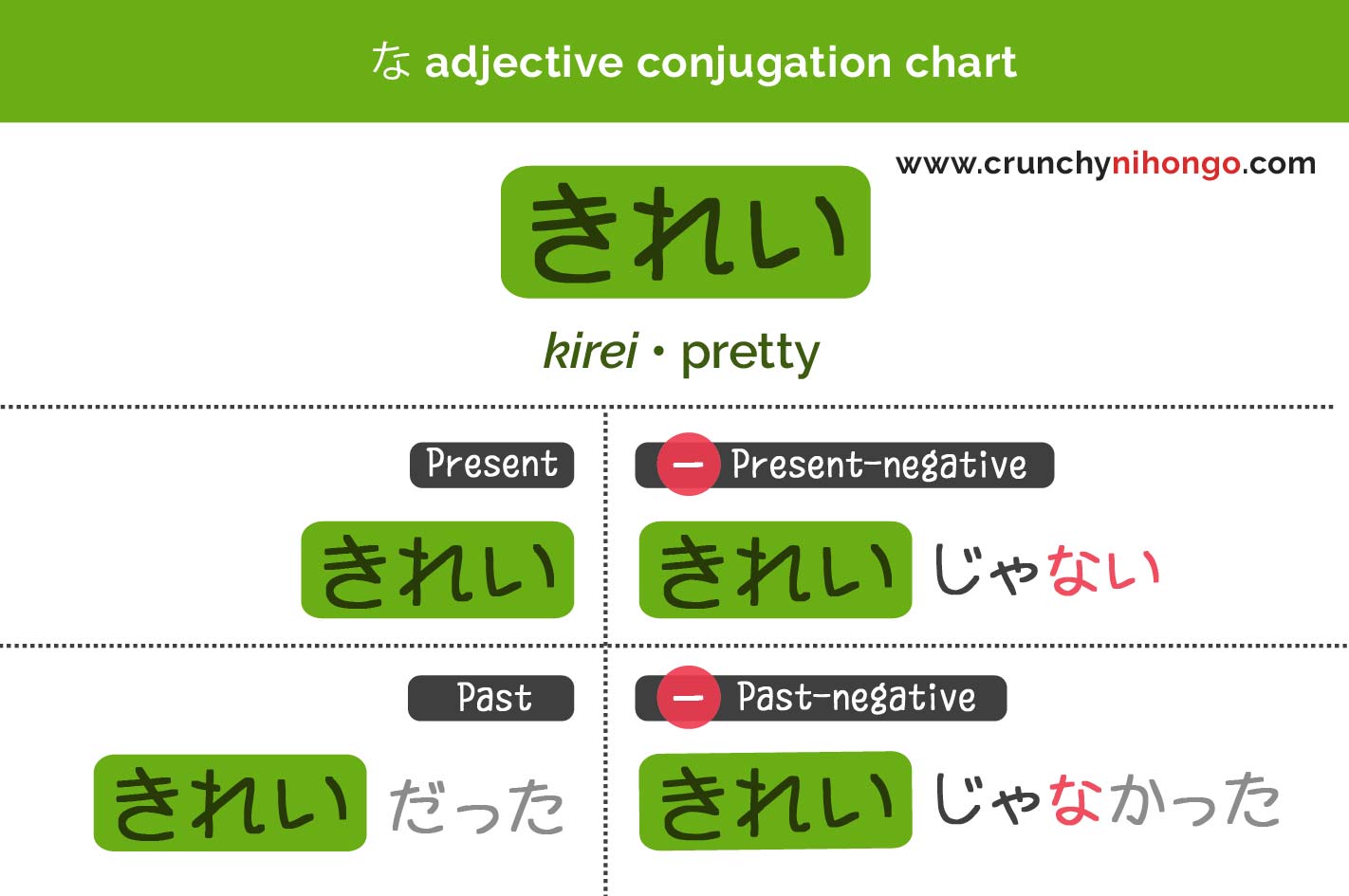
Sample Sentence
そのモルモットは
Sono Morumotto wa
That Guinea Pig
そのモルモットは
Sono Morumotto wa <emp”>kireideshita
That Guinea Pig
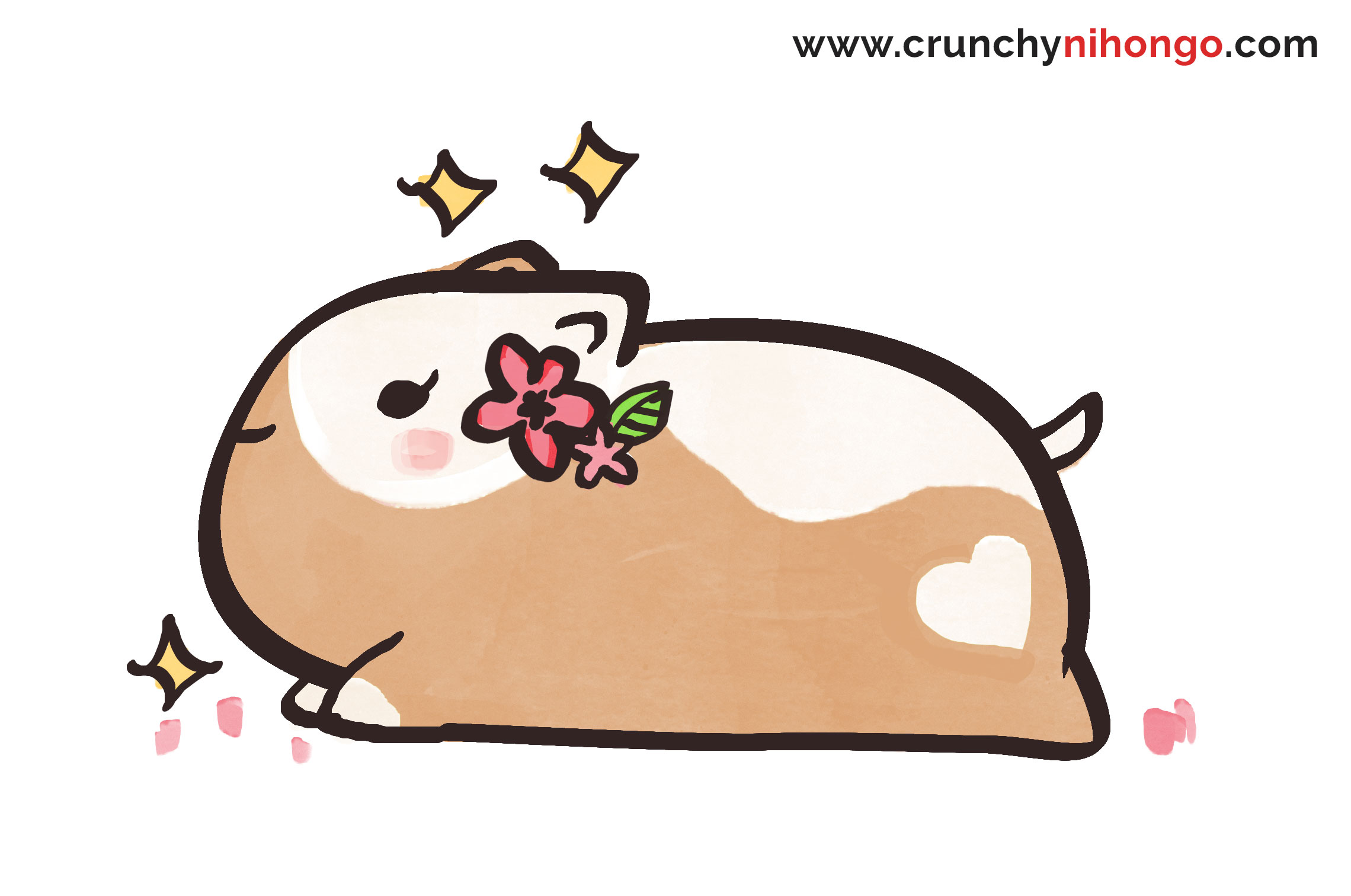
そのモルモットは
Sono Morumotto wa
That Guinea Pig
そのモルモットは
Sono Morumotto wa
That Guinea Pig

*all sample sentence are written as formal/polite version. To make it informal, you can drop the です.
** でした is the formal/polite version of だった
BASIC ROLES OF ADJECTIVE
Now we’re going to learn the roles of adjective. First is as noun modifier.
As a Noun Modifier
Noun modifier means that we are using adjective such as
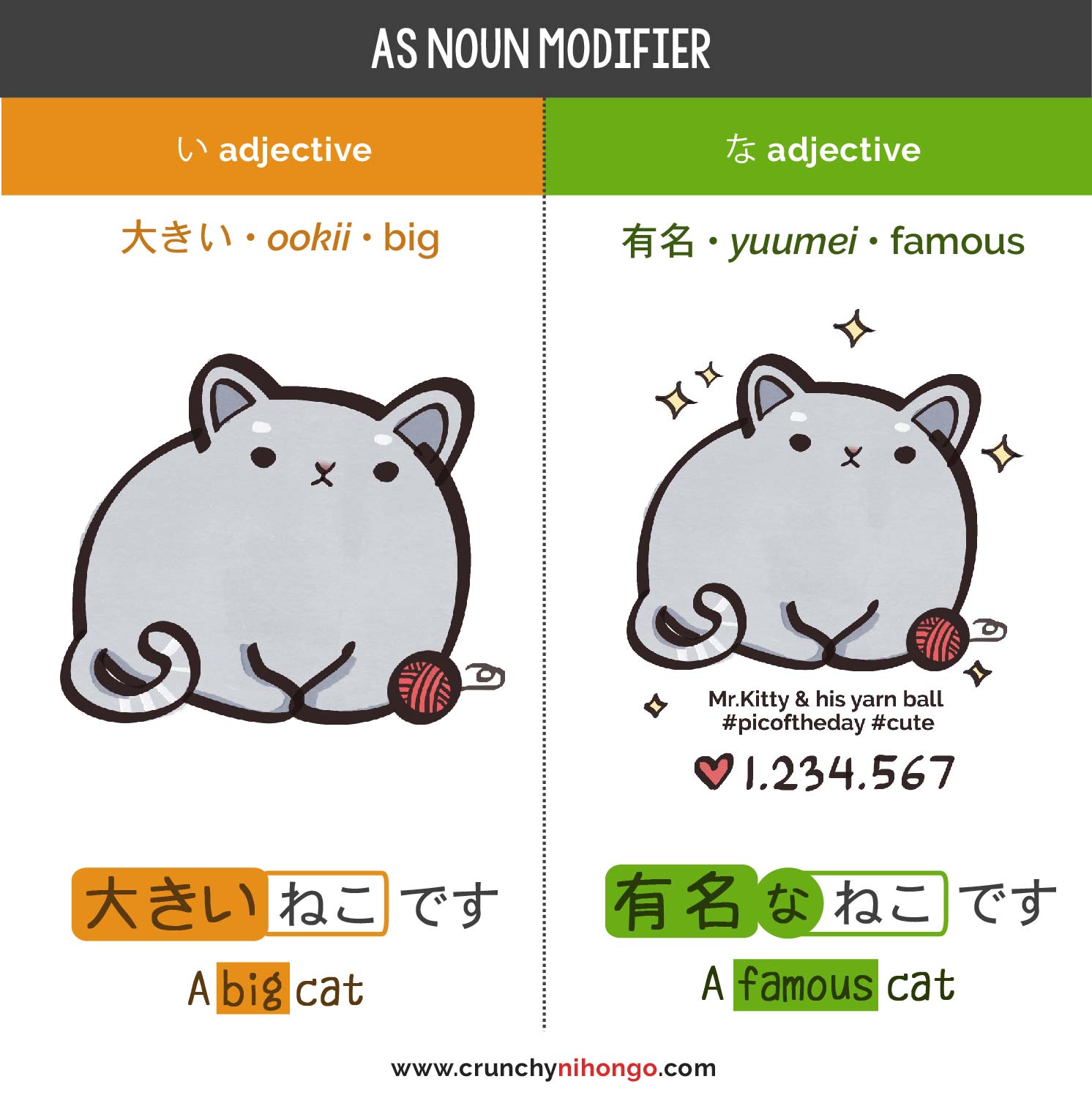
As you can see, when you use Japanese NA-adjective as noun modifier. We need to add な between the adjective and noun. Now you know as to why the な-adjective is named that way.
Did you know that you can also use noun to modify/add atribute to another noun using particle の?
It’s similar to
の
Kanojo NO heya (Her room)
:: Adding
の
Eki NO chikaku (Nearby the station)
:: Adding
の
Midori NO hon (The green book)
:: Adding
As Predicates
Predicate is when we use an adjective to describe a noun. As in [THAT CAT IS BIG]. Used as predicates, the only rules you need to remember is to never put だ after I-adjective.
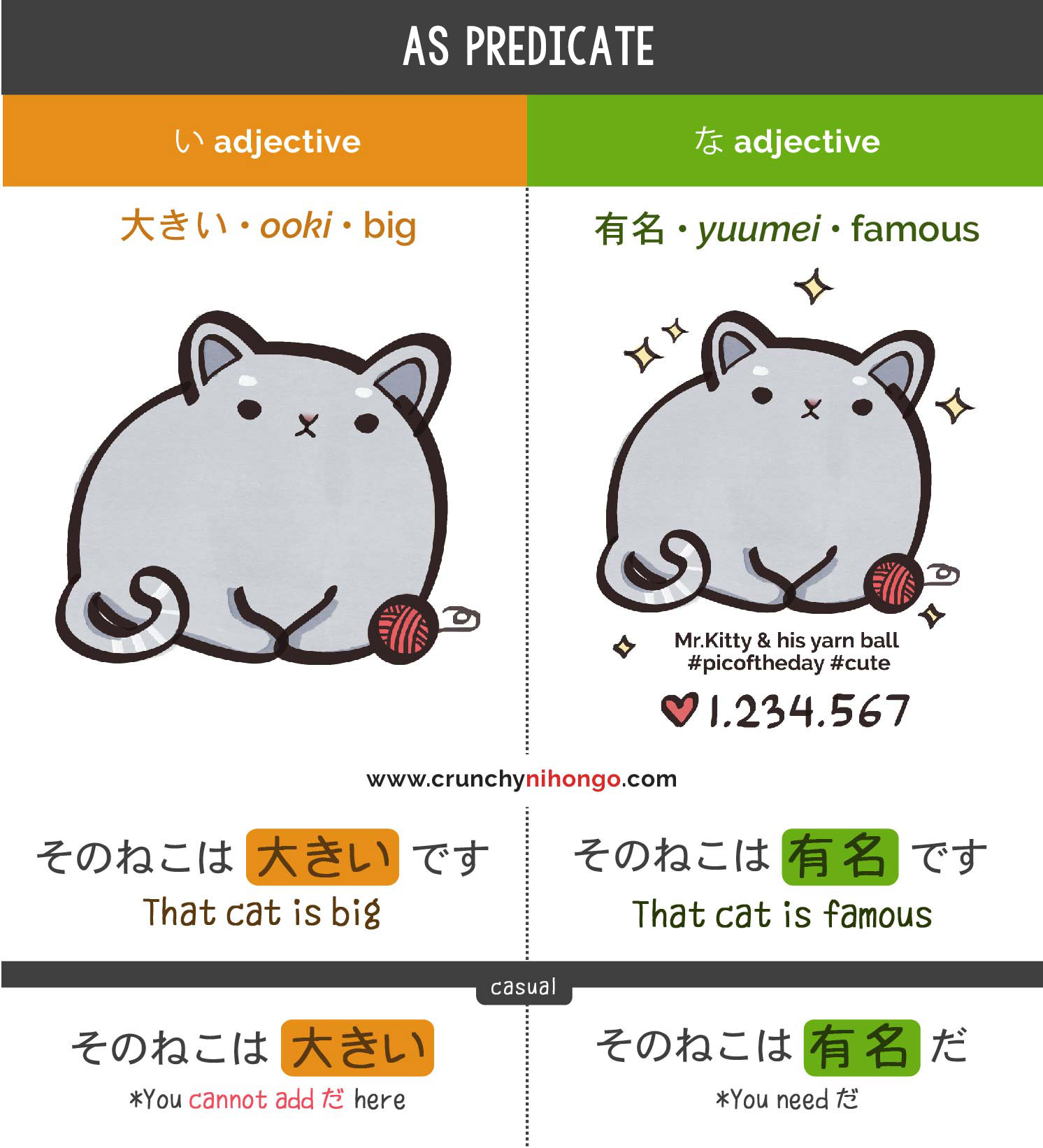
As Adverbs
We can create adverbs from adjective as what we can do in English

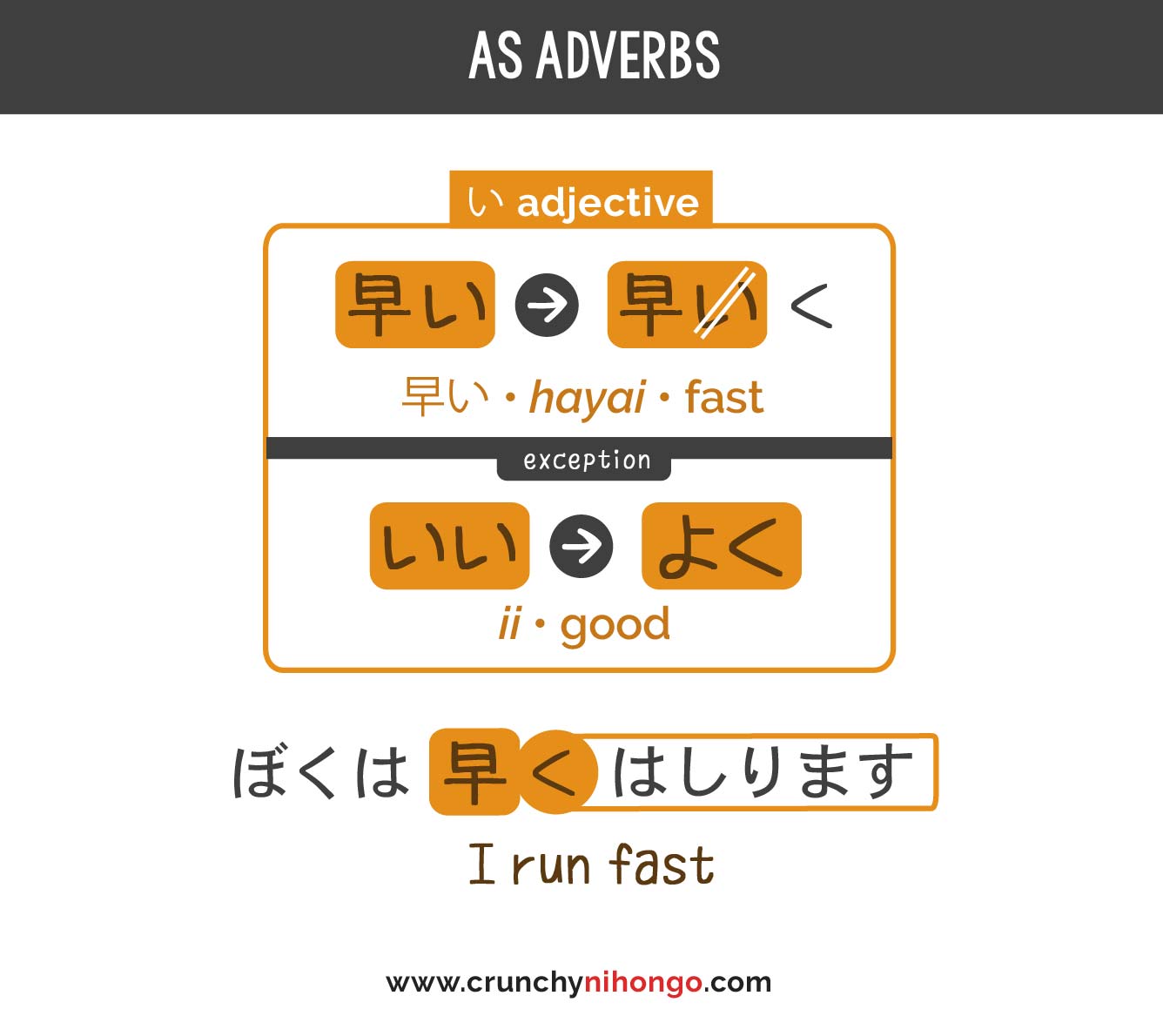
CONNECTING ADJECTIVES
Connecting Japanese adjective isn’t hard. The rules are quite simple. You just need to conjugate all the adjective except the last one.
You simply remove い and turn it into くて for I-adjective and add で for Na-adjective.
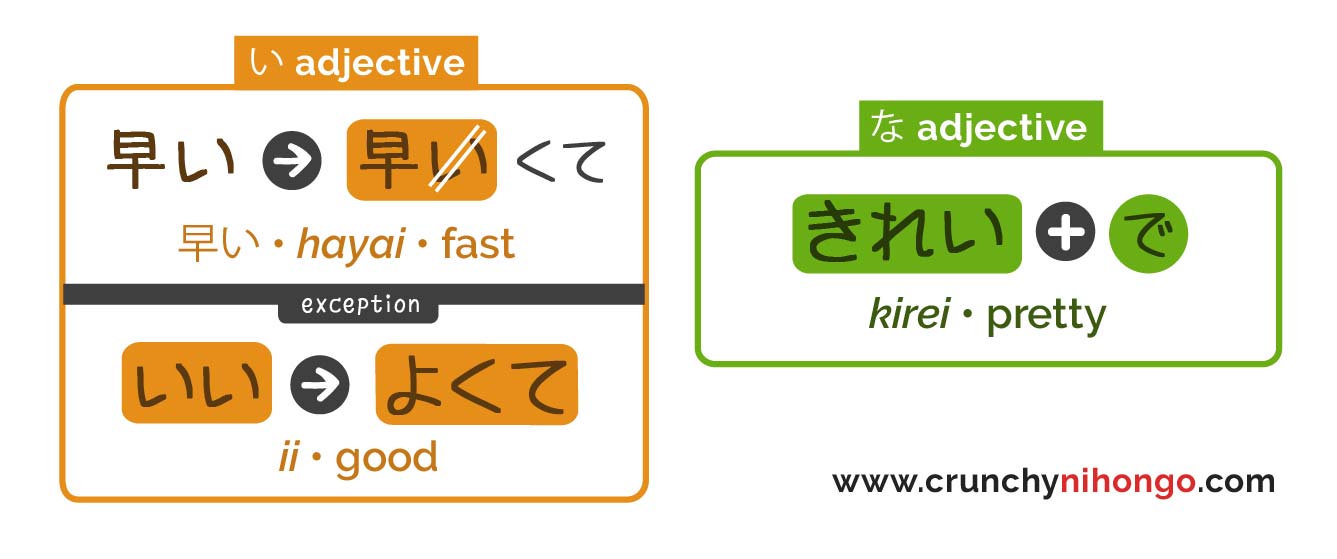
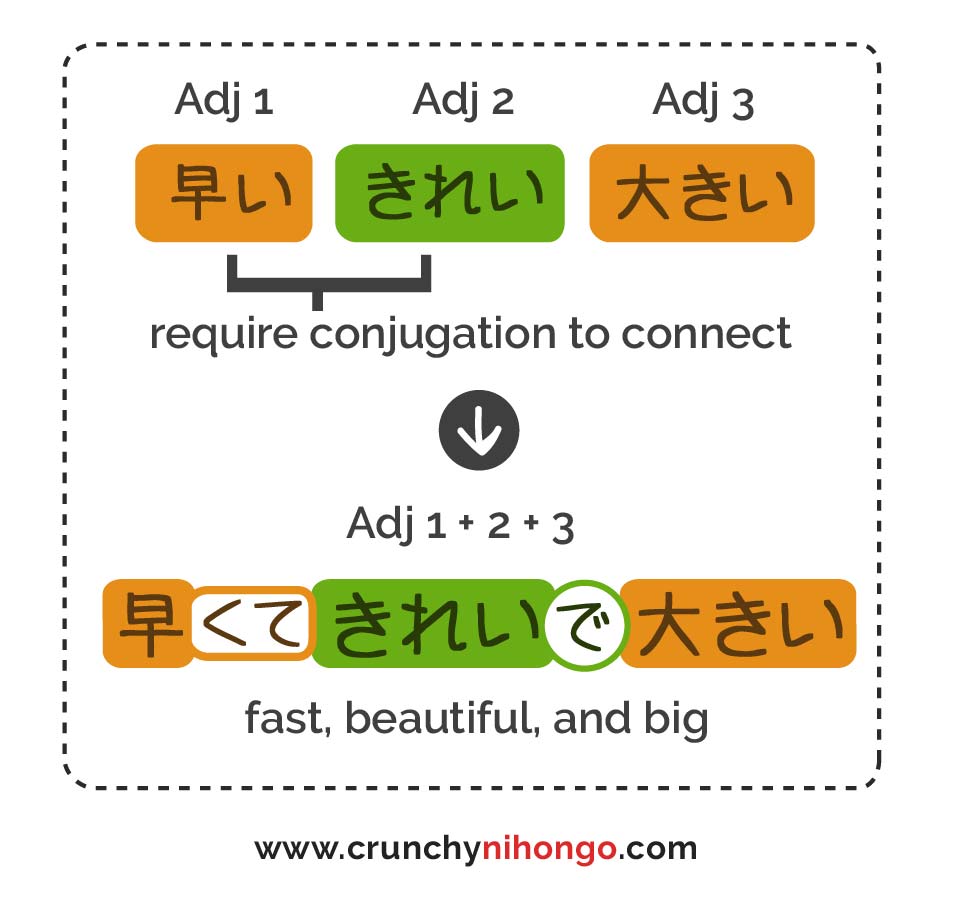
It is not natural to combine adjective of contradicting nuance in Japanese.
This means that when you are meant to praise something, you cannot said a bad attribute and vice versa.
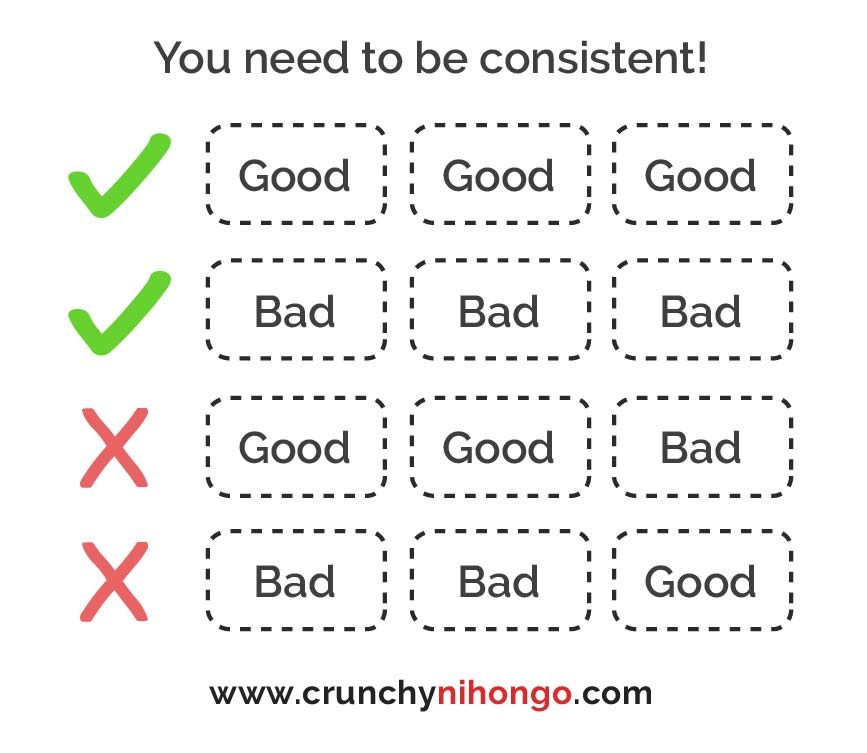
But to understand what bad/good in Japanese require experience and knowledge. For example, wide is good, while narrow is bad. So you cannot say that your room is beautiful and narrow. This is because narrow in Japanese is identical with cramp space. So saying that your room is beautiful and cramp is inconsistent.
“Are you praising your room or what? I cannot understand it!” (┛◉Д◉)┛彡┻━┻
Q: How to connect 2 different attribute then?
A: We can use
彼女はきれい
Kanojo wa kirei
She is beautiful
AND THAT’S ALL ABOUT JAPANESE ADJECTIVE BASICS YOU NEED TO KNOW
But for you who are looking for a thorough explanations regarding Japanese adjectives and adverbs to understand more about the logic, difference in nuance, and how they work, you can check out this book here. The Handbook of Japanese Adjectives and Adverbs
The book is written to explain the background and logic of Japanese adjective and adverbs, and the similarity / difference between Japanese and English version. So it will help you to understand how Japanese adjective and adverbs works.
The best part about the book is explanation regarding subtle difference of nuance between each word choice. For example, 時々 (tokidoki means once in a while) and たまに (tama ni also means once in a while, but the time period is longer than tokidoki). So you use 時々(tokidoki) when you say that you sometimes work overtime (a few days within a month) and たまに (tama ni) when sometimes means (a few days within a year).
Japanese adjectives and adverbs is one of the most important key to understand Japanese, so if you’re the type of person who need textbook reference to guide you to study Japanese, The Handbook of Japanese Adjectives and Adverbs is one of the book you should read.
ADDITIONAL INFORMATION ABOUT ADJECTIVE
Ooki vs Ookina – Chiisai vs Chiisana
You might hear words similar to
Eventhough they have
This image below will help you to understand the difference between 大きい and 大きいな
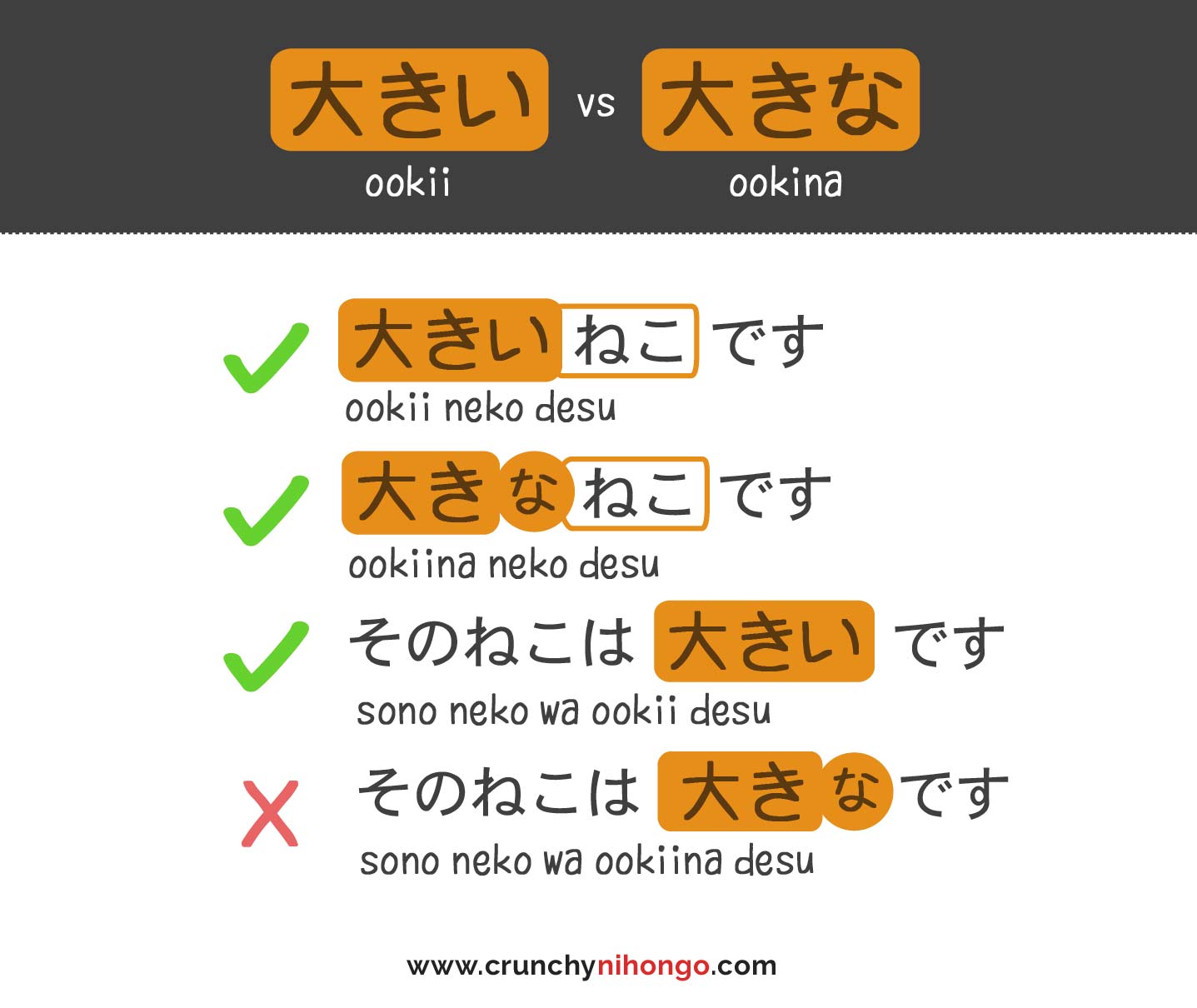
Tips To Differentiate I-Adjective And NA-Adjective
People often ask “How do we know if an adjective is the I-adjective or Na-adjective?”. There are a few things that can help you to differentiate
Here’s the list below:
1. For 100% accuracy, use your dictionary.
Below is links to offline Japanese dictionary you can download
Takoboto for Android | Imiwa for IOS
2. Most of the time,
But you might notice that in rare case, there are some
きれい Case
In きれい, actually, if you check in dictionary, it is written as full kanji 綺麗. There is no
好き Case
好き (suki:like) sounds like it end with I but it really isn’t
What we’re looking for is
嫌い Case
Why 好き (suki:like) and 嫌い (kirai:hate) are considered as adjectives?
Think of like as in when something/someone have a
If the explanation provided above is too simple and isn’t enough for you, you can try to read The Handbook of Japanese Adjectives and Adverbs since the book best feature is explanation of stuff like this.
3. Note: Treat this one as “fun fact” only.
If you get a list of common
For example,
While,

Hello! In the part of kirei in past Tense you put kireidatta instead of kireikatta in the picture
Hello! The past for Kirei as (na-adjective) is Kireidatta. While Hayai as (I-adjective) is Hayakatta. So the picture is correct while indeed there is a typo in the past tense sample sentence. It has been fixed now thanks to you 。゚✶ฺ.ヽ(*´∀`*)ノ.✶゚ฺ。
You’re welcome :). I am new to this page. Let me tell you that your page is really creative. I like the pictures and designs and the way you explain grammar with that is easier for me to understand. So it’s all thanks to you. 🙂
Thank you *big hug* I’m glad that you like it! Please look forward to future lessons 。゚✶ฺ.ヽ(*´∀`*)ノ.✶゚ฺ。 Happy learning~
You’re the best. My teacher is sick, so I have to study adjectives on my own and your explanation is really nice. It’s like adjectives for dummies. 😀 Thank you very much! 🙂
“Japanese adjectives for dummies”! lol. It was actually written to make it easy to learn, we’re glad that it help you! Check out our other lessons too and let us know your feedback 。゚✶ฺ.ヽ(*´∀`*)ノ.✶゚ฺ。 You’re welcome btw~ ヾ(@°▽°@)ノ
is learning japanese not difficult?
We believe there’s always a challenge to learn every skills. Reading Japanese alphabet is quite easy, you could master them in a few days just by starting with our guide here http://crunchynihongo.com/easy-hiragana-guide-1/, but to learn the language require dedication and time 😀
There will be difficult aspect, but as long as you want it bad enough, you will surely get through it! 😉
Hello, thank you very much for your lessons CrunchyNihongo.
I have a question about a sentence in the section, “As a Noun Modifier.”
駅 の 勉強
Eki NO chikaku (Nearby the station)
:: Adding nearby attribute to a station
Several online dictionaries/translators say that “勉強” (べんきょう) is “to study.”
The dictionaries/translators says that “near” (ちかく) is “近く”.
Sorry if I am wrong. I’m not sure if this is a typo or I misunderstood something. Thank you.
You’re right! We also didn’t know how it could end up like that, thanks for reporting 😀
Hello!
I’ve been reading articles on your site for a while, and I fond it great!
But as I go back to learning japanease after a break of several months, I see the pictures explaining things are now gone! =(
It is a known issue? Are you planning to put them back? the pictures really help a lot, and your website is really the best I could find to understand a lot of notions, so I’d be sad if they’d be gone forever =(
Anyway, great job, I wish you the best!
Hey! yes, the website did break and we didn’t have the resource to work on it :’) We’ve tried to fixed it. It seems working out now, but please do report if you found another problem 🙂